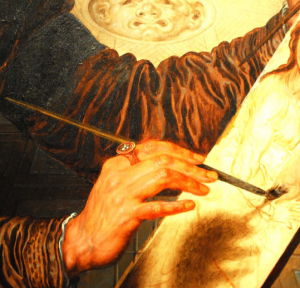London, The Courtauld Institute of Art, October 26, 2013
Deadline-CFP: 21 juin 2013
 Work in Progress: Bringing Art into Being in the Early Modern Period
Work in Progress: Bringing Art into Being in the Early Modern Period
Fifth Early Modern Symposium
Saturday 26 October 2013
The Courtauld Institute of Art, Somerset House, Strand, London WC2R 0RN
CALL FOR PAPERS
Complex narratives spanning months, years or even decades exist behind the single bracketed date attached to artworks to indicate their moment of execution or completion. This one-day symposium will explore the ‘ante-natal’ development of early modern art from its conception to its ‘quickening’ and eventual birth. The process fascinated contemporary theorists and continues to raise questions for modern art historians. For example, when was an artistic project considered finished or unfinished? What terms were used to indicate the various stages of bringing an artwork into being, and what implications did these terms have for authorship and authenticity? The creation of art is not the work of a moment or achieved at a single stroke; it involves a series of transpositions from idea to study or plan, from sketch to painting, from plan to building and so on. How did early modern art reflect on the process of its own making?
We invite 20-minute papers considering artistic ‘work in progress’ in the early modern period (c.1550-1800):
• what processes of translation and transposition were involved in moving art out of the realm of ideas into the material world? Papers might analyse and discuss the evolution of an artwork from concept to creation or construction and consider each phase of development in turn. This could involve close examination of plans, drawings, studies, sketches, maquettes or bozzetti for the same artistic project and consideration of how each stage shaped the end product
• what did contemporary ideas, religious beliefs, and philosophical theories (those of Spinoza, for example) have to say about creativity – and how might these have informed the conception of the early modern work of art? As Peter Conrad (Creation: Artists, Gods & Origins, 2007) has suggested, ‘any investigation of art has to ponder the notion of God’s creation’. Vasari paid homage to the ‘ultimate initiator’ in his Lives of the Most Eminent Painters, Sculptors, and Architects and described Genesis as the adventures of a ‘creative intellect’
• how might the early modern preoccupation with the idea of progress have been relevant to the creation of art?
• was creativity gendered in the period? Did the early modern version of sexual reproduction – in which women simply encased the precious, implicitly masculine kernel of creativity – affect contemporaries’ understanding of the way art was generated?
• can current theories and methodologies illuminate the process of art-making in the period? What can material data and scientific research methods, such as infra-red reflectography, dendro-chronology and chemical analysis of pigments, tell us?
• what happened when artistic aspiration collided with social and political realities or encountered financial and practical constraints? Papers might describe artistic indecision and frustration and examine the choices and creative opportunities that resulted. How did projects come to be altered or radically revised in scale and ambition? What were the implications of rejection in such cases as Caravaggio’s ‘St Matthew and the Angel’ for the Contarelli chapel in San Luigi dei Francesi?
• drawing on Victor Stoichita’s study of ‘meta-painting’, papers could explore how early modern artworks reflected on their own bringing into being and making. Vermeer’s ‘The Painter in his Studio’ (c.1666), ‘Las Meninas’ by Velázquez (1656-7), and Panini’s ‘Modern Rome’ and its pendant ‘Ancient Rome’ (1757) are examples of the many artworks from the period that take the process of artistic creation as their subject.
We invite proposals from graduate students, junior scholars, curators, and conservators for papers that explore one or more of the above-mentioned issues in any artistic medium (painting, sculpture, architecture, decorative arts, print media, graphic arts and the intersections between them). Theoretical and technical approaches are equally welcome.
We do not at present have a budget for travel and accommodation for speakers. Students from outside London are encouraged to apply to their institutions for funding to participate in the symposium.
Please send proposals of no more than 300 words along with a 150 word biography by 21 June 2013 to anya.matthews@courtauld.ac.uk and giulia.weston@courtauld.ac.uk
Organised by Anya Matthews and Giulia Martina Weston (The Courtauld Institute of Art).
URL de référence : http://arthist.net/archive/5304

Leave a Reply
You must be logged in to post a comment.